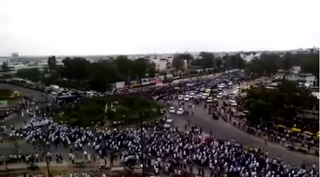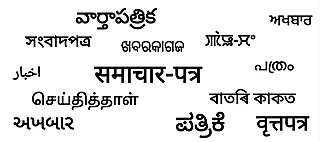Bhatia is a group of people and a caste found in Punjab, Sindh and Gujarat. Traditionally, they have been a trading and merchant community. The Bhatias primarily live in Northwestern India and Pakistan. The Bhatias, Lohanas and Khatris were similar communities and were known to intermarry. The Bhatias recruit Saraswat Brahmins as priests.

Narsinh Mehta, also known as Narsinh Bhagat, was a 15th-century poet-saint of Gujarat, India, honored as the first poet, or Adi Kavi, of the Gujarati language. Narsinh Mehta is member of Nagar Brahman community. Narsinh became a devotee of Krishna, and dedicated his life to composing poetic works described as bhakti, or devotion towards Krishna. His bhajans have remained popular in Gujarat and Rajasthan for over 5 centuries. Most notably, his composition Vaishnav Jan To was Mahatma Gandhi's favorite and became popular with freedom fighters across India.
Lohana are a trading or mercantile jāti mostly in India and also in Pakistan.

Patidar, formerly known as Kanbi, is an Indian land-owning and peasant caste and community native to Gujarat. The community comprises at multiple subcastes, most prominently the Levas and Kadvas. They form one of the dominant castes in Gujarat. The title of Patidar originally conferred to the land owning aristocratic class of Gujarati Kanbis; however, it was later applied en masse to the entirety of the Kanbi population who lay claim to a land owning identity, partly as a result of land reforms during the British Raj.
The Khedaval or Khedawal is a Gujarati Brahmin community. Their traditionally served as merchants, money-lenders, pleaders, and government servants. They practice hypergamy. They are also present as priests in the Raṇachoḍarāy temple in Ḍākor.
Desai is an Indian administrative, princely or honorary title and surname.

Nagar Brahmin is a Brahmin subcaste from the Indian state of Gujarat.
Anavils are a community who despite not being numerically superior, are particularly dominant in the Surat and Bulsar districts of south Gujarat, India, where they have been significant land-owners and have an influential role in politics.

Narmadashankar Lalshankar Dave, popularly known as Narmad, was an Indian Gujarati-language poet, playwright, essayist, orator, lexicographer and reformer under the British Raj. He is considered to be the founder of modern Gujarati literature. After studying in Bombay, he stopped serving as a teacher to live by writing. During his prolific career, he introduced many literary forms in Gujarati. He faced economic struggles but proved himself as a dedicated reformer, speaking loudly against religious and social orthodoxy. His essays, poems, plays and prose were published in several collections. His Mari Hakikat, the first autobiography in Gujarati, was published posthumously. His poem Jai Jai Garavi Gujarat is now the state anthem of Gujarat state of India.
Bania is a mercantile caste mainly from the Indian states of Gujarat and Rajasthan, with strong diasporic communities in Uttar Pradesh, Madhya Pradesh, West Bengal, Maharashtra and other northern states. Traditionally, the main occupations of the community are merchants, bankers, money-lenders, and owners of commercial enterprises.
Rao Bahadur Gopal Hari Deshmukh also known as Lokhitwadi was an Indian activist, thinker, social reformer and writer from Maharashtra. His original surname was Shidhaye. Because of 'Vatan' that the family had received, the family was later called Deshmukh. Deshmukh is regarded as an important figure of the Social Reform Movement in Maharashtra.

Dalpatram Dahyabhai Travadi was a Gujarati language poet during 19th century in India. He was the father of Nanalal Dalpatram Kavi, a poet.
The Nayak are an aboriginal caste; also some Nayak are Punjabi found in India and Pakistan. Mainly Nayak follows aboriginal Bhil. According to Vinay Krishin Gidwani, the Nayaks claim that they were, historically, Bhil.

Manilal Nabhubhai Dwivedi was a Gujarati-language writer, philosopher, and social thinker from British India, commonly referred to as Manilal in literary circles. He was an influential figure in 19th-century Gujarati literature, and was one of several Gujarati writers and educators involved in the debate over social reforms, focusing on issues such as the status of women, child marriage, and the question of whether widows could remarry. He held Eastern civilisation in high esteem, and resisted the influence of Western civilisation, a position which drew him into conflicts with other social reformers of a less conservative outlook. He considered himself a "reformer along religious lines".

The Koli is an Indian caste found in Rajasthan, Himachal Pradesh, Gujarat, Maharashtra, Uttar Pradesh, Haryana, Karnataka, Odisha and Jammu and Kashmir states in India. Koli is an agriculturist caste of Gujarat but in coastal areas they also work as fishermen along with agriculture. In the beginning of 20th century, the Koli caste was recognised as a denotified tribe under Criminal Tribes Act by the Indian Government because of their anti-social activities during World War I.

The Media in Gujarati language started with publication of Bombay Samachar in 1822. Initially the newspapers published business news and they were owned by Parsi people based in Bombay. Later Gujarati newspapers started published from other parts of Gujarat. Several periodicals devoted to social reforms were published in the second half of the 19th century. After arrival of Mahatma Gandhi, the Indian independence movement peaked and it resulted in proliferation of Gujarati media. Following independence, the media was chiefly focused on political news. After bifurcation of Bombay state, the area of service changed. Later there was an increase in readership due to growth of literacy and the media houses expanded its readership by publishing more editions. Later these media houses ventured into digital media also. The radio and television media expanded after 1990.
Nandshankar Tuljashankar Mehta was an Indian Gujarati language author and social reformer. He is known for Karan Ghelo, the first original novel in Gujarati.

Mahipatram Rupram Nilkanth was a Gujarati educationist, reformer, novelist and biographer from 19th century India.
Navalram Jagnnath Trivedi (1895–1944) was a Gujarati writer, critic and editor. He served as a secretary of Gujarat Sahitya Sabha for twenty years.

Durgaram Manchharam Dave (1809–1876), popularly known as Durgaram Mehta or Durgaram Mehtaji, was a Gujarati social reformer, essayist, diarist and teacher from British India. Along with his companions he founded the Manav Dharma Sabha, the first reform association of Gujarat, at Surat in 1844, and pioneered social reform activities in Gujarat. He was the first to use autobiographical writing in Gujarati literature by keeping minutes of the transactions of the Manav Dharma Sabha with his comments and views.










